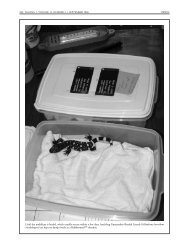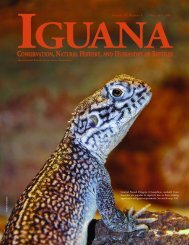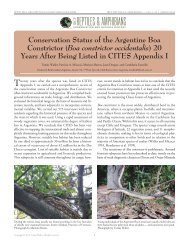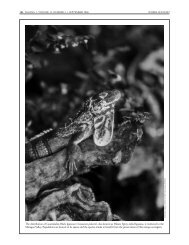Spiny-tailed Iguanas (Ctenosaura similis) in Venezuela
Spiny-tailed Iguanas (Ctenosaura similis) in Venezuela
Spiny-tailed Iguanas (Ctenosaura similis) in Venezuela
Create successful ePaper yourself
Turn your PDF publications into a flip-book with our unique Google optimized e-Paper software.
AMPHIBIANS AND REPTILES OF DOMINICA<br />
An Annotated Checklist of the Amphibians<br />
and Reptiles of Dom<strong>in</strong>ica, West Indies<br />
Esther A. Daniells 1 , Jeffrey W. Ackley 2 , Ruth E. Carter 3 , Peter J. Muelleman 4 , Seth M. Rudman 5 ,<br />
Patrick A. Turk 6 , Nelson J. Vélez Esp<strong>in</strong>et 7 , Lauren A. White 8 , and Natalie N. Wyszynski 9<br />
1 Department of Biology, Colorado State University, Fort Coll<strong>in</strong>s, CO 80523 (edan@holly.colostate.edu)<br />
2 Department of Biology, Eckerd College, St. Petersburg, FL 33711 (ackleyjw@eckerd.edu)<br />
3 Department of Biology, Earlham College, Richmond, IN 47374 (recarter07@earlham.edu)<br />
4 Department of Biology, Truman State University, Kirksville, MO 63501 (pjm563@truman.edu)<br />
5 Department of Biology, University of Rochester, Rochester, NY 14627 (srudman@mail.rochester.edu)<br />
6 Department of Biology, Avila University, Kansas City, MO 64145 (turk95917@avila.edu)<br />
7 Department of Biology, University of Puerto Rico, Río Piedras, PR 00931 (b19velez2007@yahoo.com)<br />
8 Environmental Science Program, Oklahoma State University, Stillwater, OK 74078 lauren.a.white@okstate.edu)<br />
9 Department of Psychology, University of Tennessee, Knoxville, TN 37996 (nwyszyns@utk.edu)<br />
Travel writers have suggested that if Christopher Columbus<br />
were to take a Caribbean cruise today, Dom<strong>in</strong>ica might be<br />
the only West Indian island he would recognize. In an age when<br />
an ideal tropical paradise must <strong>in</strong>clude golf courses, five-star<br />
restaurants, tower<strong>in</strong>g hotels, cruise-ship berths, manicured white<br />
beaches, and swimm<strong>in</strong>g pools adjacent to the ocean, the drastic<br />
changes to which other dest<strong>in</strong>ation islands have been subjected<br />
are understandable. However, an accident of geology spared<br />
Dom<strong>in</strong>ica from that fate. The island is a complex of volcanic<br />
peaks, the highest of which (Morne Diablot<strong>in</strong>) reaches 1,446 m<br />
above sea level, result<strong>in</strong>g <strong>in</strong> an <strong>in</strong>timidat<strong>in</strong>g terra<strong>in</strong> that has<br />
slowed the seem<strong>in</strong>gly <strong>in</strong>evitable march of “progress.” Because<br />
level lowlands suitable for sugarcane plantations dur<strong>in</strong>g the colonial<br />
era do not exist and tourism-oriented development is m<strong>in</strong>imal,<br />
the <strong>in</strong>evitable consequences of deforestation and decl<strong>in</strong><strong>in</strong>g<br />
biodiversity are largely absent.<br />
In sharp contrast, the potential for effective conservation is<br />
considerable, and Dom<strong>in</strong>ican authorities have taken steps to preserve<br />
two unique natural treasures: The forests, which still cover<br />
more than 60% of the island, and the animals that live <strong>in</strong> the<br />
largely natural habitats that rema<strong>in</strong>. The amphibians and reptiles<br />
<strong>in</strong> particular comprise what may well be the most “natural” herpetofaunal<br />
community <strong>in</strong> the entire Lesser Antillean archipelago.<br />
Although conserv<strong>in</strong>g forests and their <strong>in</strong>habitants might<br />
not be a sell<strong>in</strong>g po<strong>in</strong>t for the vacationers to whose <strong>in</strong>terests developers<br />
cater, Dom<strong>in</strong>ica benefits by promot<strong>in</strong>g ecotourism, and<br />
markets itself as the “Nature Island.” By not compet<strong>in</strong>g for visitors<br />
whose sole <strong>in</strong>terest is recl<strong>in</strong><strong>in</strong>g <strong>in</strong> the lap of luxury,<br />
Dom<strong>in</strong>ica provides the chance to experience natural habitats,<br />
<strong>in</strong>creas<strong>in</strong>gly rare commodities that more <strong>in</strong>tensely developed<br />
islands are about to lose entirely. However, <strong>in</strong> order to place a<br />
value on natural resources such as the herpetofauna, authorities<br />
must have access to reliable <strong>in</strong>formation about its distribution,<br />
natural history, and conservation status. Here<strong>in</strong> we present a<br />
summary of our observations on Dom<strong>in</strong>ica’s diverse herpetofaunal<br />
communities with the hope that it will rema<strong>in</strong> relevant to<br />
com<strong>in</strong>g generations.<br />
<br />
IGUANA • VOLUME 15, NUMBER 3 • SEPTEMBER 2008 131<br />
Dom<strong>in</strong>ica (754 km 2 ) is one of the volcanic W<strong>in</strong>dward Islands <strong>in</strong> the<br />
Lesser Antilles. The rugged topography and lack of flat lowlands spared<br />
the island from the alterations (typically associated with sugar plantations)<br />
to which most other West Indian islands were subjected dur<strong>in</strong>g<br />
the colonial period.<br />
JOHN S. PARMERLEE, JR.








